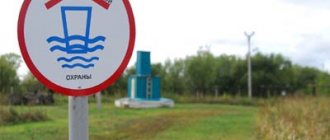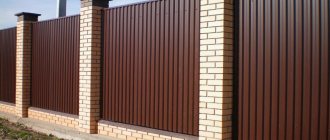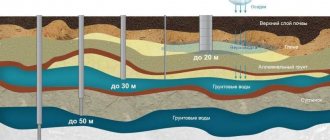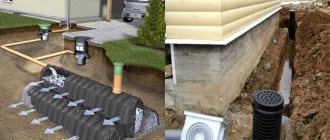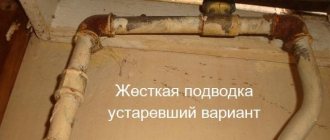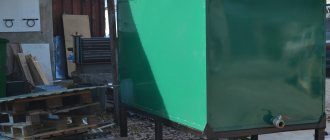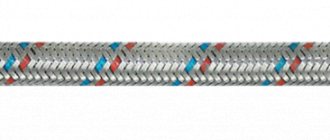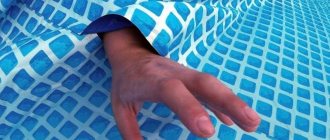When purchasing a private house or summer cottage, the first priority is to install a water supply system. If a main network runs nearby, you can cut a branch into it, but most often you have to drill the soil to install a water supply system. In this case, you need to know what the depth of the well for drinking water should be.
To drill a well, the owner needs to know the depth.
What determines the depth of water drilling in the Moscow region?
In Moscow and the Moscow region you can find drinking water at several levels. To determine how deep the well will be, select the purpose for water production:
- Only for technical purposes (cleaning, washing, watering). To solve these problems, a well or borehole up to 30 m deep is suitable. But the water yield will be unstable.
- We need water for drinking, cooking, and hygiene. You can find water suitable for drinking at a level from 30 m to 50 m. You may need to install filters to purify water from a well. A shallow source will last 5-10 years.
- A lot of water is required for drinking and other purposes. The source needs to last 50 years. Then you will need to drill 40-300 m. The depth of the well depends on the water needs of the site. The greater the depth of the aquifer, the greater the flow rate.
The choice of depth is influenced by the location of the site. In some areas of the Moscow region there is almost no surface water. Then you have to drill deeper into the ground in search of an aquifer.
Figure 1: Drilling a water well 50 meters deep using MGBU.
How many meters deep is the first aquifer
Let's start with the benefits of using this layer:
- Low cost of materials and work - due to the shallow depth (from 3 to 25 meters).
- There are no legal problems - the equipment of a well or well does not require permits or registration.
There are only two advantages, but for most owners of country houses they turn out to be very significant.
However, using the first aquifer will have two serious disadvantages:
- Variable well flow - the amount of water will vary depending on the time of year and weather conditions. For example, in the case of a dry summer, the water may disappear completely.
- Possibility of water contamination with fertilizers from fields and feces from cesspools.
It is better to send water from such a well for analysis. This will help determine the presence or absence of impurities and biological contaminants.
Based on the results of the analysis, it will become clear what filtration system needs to be used to purify this water.
In the worst case scenario, it may turn out that the water from the “overwater” is generally unsuitable for use!
Then you will have to drill the well even deeper - to the second aquifer.
What types of aquifers exist in the Moscow region
Groundwater is at a level of 1.5 to 5 meters. It is located between the surface of the earth and the waterproof layer (usually clay). A large number of chemical and organic impurities make water from a well or borehole unsuitable for drinking.
Interstratal water lies between two impermeable layers. It is a clear, odorless liquid. The content of hardness salts, iron and other metals is higher than normal. Average depth: 15-25 m. Before drinking water, a chemical analysis should be carried out. If it detects the presence of impurities, filters will need to be installed.
Artesian water is located under completely waterproof rock. In the Moscow region it is limestone. The depth of the artesian horizon is from 30 to 300 m. The aquifer is continuous. You can drill a well on limestone anywhere. This formation produces good quality water.
Buden interesting: Sanitary zone of the well.
Figure 2: Diagram of aquifers.
Where should the well be located?
The SanPin normative act No. 2 specifies the requirements for the location of water intake structures. The first paragraphs say that the well must be at least 30 meters away from residential buildings. However, on plots of 5-6 acres it is not always possible to comply with such requirements.
Some people, in order to save pipes and heating cables, decide to build a well next to their house. They rely on the fact that the competent authorities rarely inspect suburban areas. However, if this happens, the owner of the site will be forced to dismantle the well. The cost of several dozen pipes is not comparable to the price of drilling a new well. Therefore, it is not worth the risk.
The regulation also stipulates the minimum distances from other objects:
- Household facilities – 4 meters.
- Large roads, industrial enterprises, cemeteries, cattle burial grounds - 300 m.
- Cesspools, compost heaps, sewer septic tanks - 8 m.
It is not recommended to place wells close to beds with agricultural crops. When irrigating many crops, chemical fertilizers are used, which can end up in groundwater.
If the site is sloped, it is better to place the well in its middle part. If you drill at the lowest point, the well may flood, and the area next to it will always be in puddles. The upper part of the site should also not be used, because you will have to drill extra meters. To equip a well, you will need electricity (to connect the pump). Therefore, it is necessary to take care of the electrical wiring in advance.
Types and depth of water wells in the Moscow region
The Abyssinian well collects water from the upper layers of the soil. Depth: up to 8-10 m. To create a source, pipes connected by threaded sections are driven into the ground. At the lower end of the pipe there is a filter with a spear-shaped tip.
Figure 3: Abyssinian well design.
Sand wells collect water from a level of up to 30 m. The water is raised to the surface by a submersible pump. In Abyssinian wells, unlike sand wells, a pumping station or surface pump is used.
A well on sandstone collects water from a level of 40 to 80 m. At this level there are second aquifer sands. But in some areas of the Moscow region this layer is absent. The sand layer gives up to 1500-2000 liters per hour.
Figure 4: Sand well design.
An artesian well collects water from underground limestone. The depth of the well can be from 30 to 300 m. Water loss level: 5000 or more liters per hour. Service life: minimum 50-60 years. The liquid quality is good due to soil filtration.
Figure 5: Artesian well design.
License and permitting documents
You will not need documents and licensing in the following cases:
- the intake occurs from the surface water horizon, which is not registered in the relevant state register;
- the system is not connected to city and regional consumption systems;
- consumption should not exceed 100 cubic meters of water per day;
- no commercial activity - only personal consumption.
From time to time, regulatory authorities carry out random inspections. If a violation is detected, a warning is given, which allows you to issue a license within a certain time frame. If the second inspection reveals violations, a fine is issued. Only 3 times the well is officially sealed and water intake is prohibited.
Which well is better to choose for drinking water in the Moscow region
We advise choosing limestone to produce water that is potable.
This aquifer is located at great depth and contains the purest water. Before entering the layer, water passes through several layers of sand and clay. These layers act as natural filters.
Let's determine the advantages of a well for limestone:
- High performance.
- Good quality of extracted liquid.
- Uninterrupted water supply at home.
- The water yield level does not change throughout the year.
- Suitable for permanent and seasonal residence.
- Completely hygienic design.
- The design is not dangerous for children, unlike a well.
- The water supply system will last at least 50 years.
In some areas of the Moscow region, flooded limestone lies at a level of 200 m. In these areas, you can drill into deep sand instead of limestone. The quality of water extracted from sandstone is almost as good as that of artesian water.
What laws govern private water supply?
The main legislative acts whose norms regulate the issue of obtaining a license for sources of personal water supply:
- Law of the Russian Federation dated February 21, 1992 No. 1295-I “On subsoil” (latest edition);
- Resolution of the Supreme Court of the Russian Federation dated July 15, 1992 No. 3314-I (as amended on April 5, 2016) “Regulations on the procedure for licensing the use of subsoil”;
- Instruction of the Committee of Geology and Subsoil Use (Roskomnedra) dated 04/14/1994 “On the application of the “Regulations on the procedure for licensing the use of subsoil”.
Identified violations of these acts will be the basis for the imposition of fines and other penalties on individuals and legal entities.
How to find out the depth of a well for your locality
The website has an interactive depth map.
You can use this map to determine the approximate depth of a well in an area. Our map is compiled using the Yandex maps service engine.
How to properly use the interactive map on the website:
- Enter the territory's address into the search form in the upper left corner.
- Click on the "Find" button. The object should appear in the center of the map.
- If your village is not yet on the map, enter the nearest known address.
- Move the map with your mouse to find the nearest sources and find out their parameters.
- Use the "+" and "-" buttons to zoom in or out on the map.
Based on the level of water in nearby areas, you can estimate the approximate depth for your territory. But the method does not provide one hundred percent accuracy. The differences in the occurrence of the aquifer in neighboring areas can reach a couple of tens of meters.
Buden is interested: How to check the depth of a well after drilling.
Preparing for measurement
Moistening conditions and the depth of groundwater are quite closely related. When planning to take measurements, you need to choose the right time. There should be no drought or prolonged rains. All weather conditions affect the measurement results.
To determine the depth of groundwater, you need to use one of the simple methods. To do this, you need to prepare all available tools and materials. The tools you will need are a regular bayonet shovel, a drill, and a tape measure. You also need to prepare a long rope.
In addition to tools, certain chemical elements are needed. These are sulfur, quicklime and copper sulfate. Different techniques will require one or another available means.
Table with prices for drilling for drinking water
A complete table with well prices for each urban district is located in this section of the site.
Below we provide an average table of prices for work with different types of casing. The cost will vary slightly depending on the region of the Moscow region.
| Casing material | Price 1 m (rub.) |
| uPVC pipes 125 mm | 2.400 |
| uPVC pipes 129 mm | 2.550 |
| uPVC pipes 140 mm | 2.750 |
| uPVC pipes 170 mm | 3.150 |
| Steel pipes 133 mm | 2.300 |
| Steel pipes 159 mm | 2.500 |
| Casing steel 133 mm + HDPE 117 mm | 2.550 |
| Casing steel 159 mm + HDPE 125 mm | 3.100 |
The indicated price consists of:
- cost of casing pipes;
- cost of drilling fluid;
- equipment delivery;
- payments for the work of drillers;
- travel expenses;
- depreciation of the drilling machine.
You can calculate the basic estimate yourself by multiplying the figure from the table by the expected depth.
For most areas in the Moscow region, 125 mm uPVC pipes are suitable. The second figure for calculation can be found on the interactive map.
Why is it worth ordering wells in
We have been drilling for more than 20 years. During our work, we studied the characteristics of each district of the Moscow region. We are ready to work on projects of any complexity and take on tasks that other drillers refuse.
Advantages of our company:
- We go to the customer’s address without prepayment.
- A free engineer visit is possible to assess working conditions.
- We own our own fleet of drilling equipment.
- The fleet includes small-sized units.
- We do not use seasonal workers.
- We employ professionals with proven experience.
- The warranty on artesian wells is valid for 10 years.
- We provide post-warranty service.
carries out not only water drilling, but also construction. After drilling work, we are ready to install water supply equipment. We offer several working connection schemes to choose from. The cost of the arrangement package: from 139,420 to 250,576 rubles.
Stages of arrangement
Regardless of whether the well is being developed on its own or with the involvement of specialists, this process takes place in several stages :
- determining the type of well and drilling technology;
- selection of drilling equipment, tools, consumables, equipment;
- arrangement of a caisson, if provided for by the design;
- drilling the first section of the well with installation of casing;
- drilling the second section of the well, securing it with pipes;
- cleaning the drill column when passing through a sandy or clayey horizon;
- achieving an acceptable water table;
- installation of a bottom filter of a hydraulic structure;
- fixing the casing, checking the tightness of the structure, installing the cover.
The first water horizon encountered when drilling a source does not always produce liquid of the required quality. Then drilling continues until the next water layer, which will produce liquid suitable for human consumption in the required volume.
